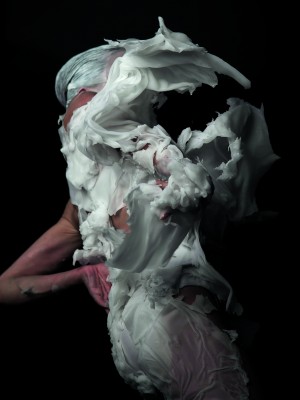Current Obsession:
In one of the interviews you talked about an intuitive impulse to put a material onto human skin, even if it doesn’t belong there, e.g. flooring material, to create tension between the two. What does this tension mean to you? Why is this tension important? It seems like a great way to talk about contemporary jewellery, even though you have little to do with it.
Bart Hess:
Combining a material and a human body is a ‘red thread’ running through my work. For me it’s about creating a tension between the two almost as if they fuse, but they never totally do. The physical reaction when doing so is of great importance for me. Not only for a model during a shoot, but even more so for the audience. Showing the skin and how it reacts to, for example, the weight of the material, adds to the experience I want to convey. It’s about the subtle details that make the audience imagine experiencing the materials without physically doing so. It has an uncanny feel to it, maybe fetishist, some say, while I look for the boundaries of both the body and the material.

CO:
What is your first memory of the future? When do you remember the first time thinking about the future?
BH:
I remember as a kid being on holidays and wanting to be Superwoman. That’s no longer the case. The future has become something more abstract to me. I use it as a motivation while feeling stuck in my work or when I’m on an airplane, which I hate. It’s a way of visualizing a future me that guides me in life.
CO:
For Lisbon Architecture Triennale you have worked on a new human from the apocalyptic future. Who is he?
BH:
For the Lisbon Architecture Triennale I’m working on my new project called Digital Artefacts. The exhibition I’m a part of, Future Perftct, brings together an ensemble of scientists, technologists, designers, futurists and science fiction authors to collectively develop the props, spaces, cultures, machines and narratives of their own brave new future city. In Digital Artefacts I combine installation, performance and video to envision the human body in this future city. The term ‘digital artifact’ is used to describe defects in digital image quality. The most common example of this is the quality change of digital imagery within the use of compression. When I work with several different effects in video software, suddenly the most extreme forms with bizarre colour patterns can occur. These forms usually appear within a fraction of a second and are a direct occurrence of my actions in the physical world. It is this boundary between the psychical and digital world that I search for in my work. T he digital world gives me a new view of the reality, one that is boundary-free, fluid, neither material nor immaterial. I find ways to translate coming from me: I think at the end of the day people want to shut off all of these external influences, take off their clothes and just be naked.
CO:
What are the tools and means of the future? Elaborate on your vision of fusion between the human body, animalistic elements and technology.
BH:
I think a big part of the future is translating and making the digital physical. There is this fear of the digital and its role in the future. Children swiping over a book like it’s an iPad losing their senses. I rather look at it from a different point of view where we bring a sense of romance back to technology. I took a similar approach in my collection A Hunt for High Tech. The ancient idea of going on a hunt, but with a twist. I imagined animals that could be genetically manipulated – part robot, part biological organism. I imagined how they would move in their environment and what they would feel like to touch. I thought about tactile qualities like the direction of hair growth with its dimensionality and the reflective qualities of scales. T he end result is a high-tech fantasy in which the forms suggest that they were not made by hand but were grown in a lab or originated from an alien creature.
CO:
What is/was your biggest investment in the future?
BH:
Keep defying genres and disciplines. Even though my work gets branded as either fashion, art or design I’m personally not too aware of this while I’m creating. My work circles around materials and I use different mediums to enhance the qualities and characters of these materials. Within this process I won’t restrain myself to a discipline, the work will choose and create it for me.

This article was first published in the #2 The Youth Issue of Current Obsession Magazine, AW2013.





